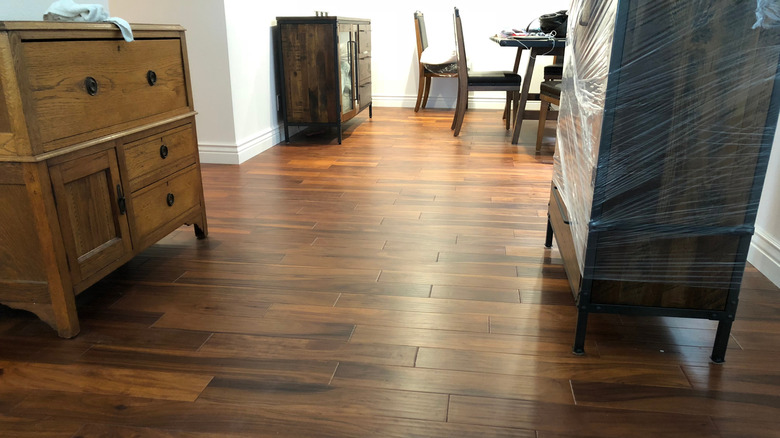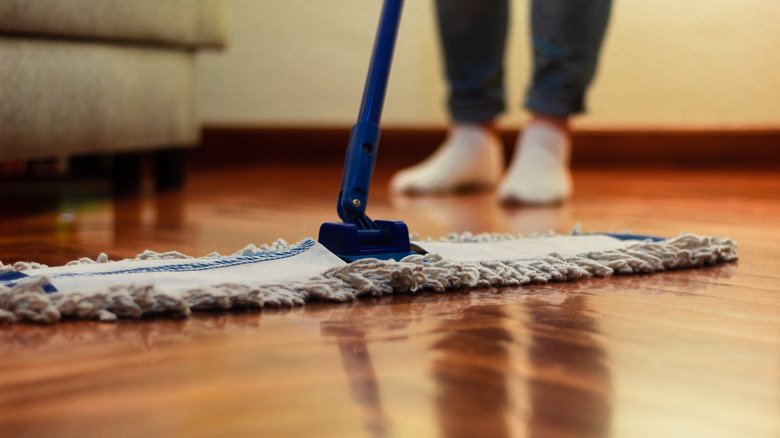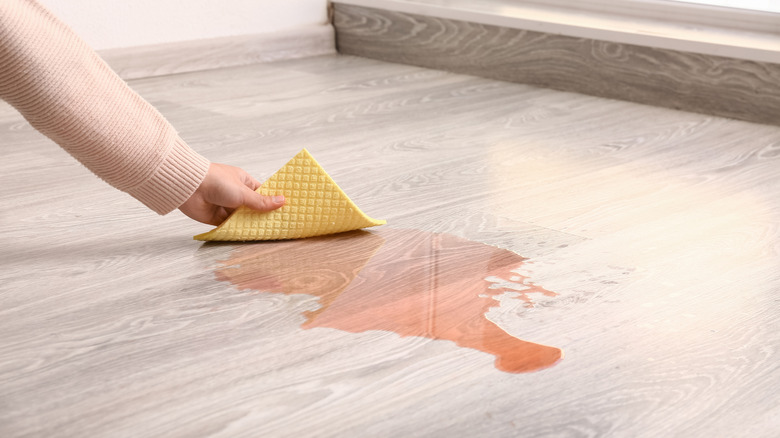How To Clean Engineered Wood Floors Without Causing Damage Over Time
We may receive a commission on purchases made from links.
If you want to capture the timeless look of hardwood floors without the hefty price, engineered flooring is where it's at. In fact, engineered hardwood flooring is one of 2025's biggest trends. While maintaining this style is easier than solid wood, they can still be finicky. To avoid damaging your floors over time, opt for pH neutral cleaners and gentle tools like microfiber mops and soft-bristled brooms.
At a glance, you likely can't tell the difference between solid wood and engineered wood flooring. Rather than being made from single planks, engineered floors consist of hardwood applied over a plywood core. These layers make engineered floors resistant to moisture and temperature changes and they are less likely to warp, bow, or buckle.However, the surface is still hardwood, so this type needs to be treated with the same gentle hand of regular hardwood floors.
For basic upkeep, sweep your floors with a soft-bristled broom to avoid damaging your finish. Although you can use a vacuum, make sure that yours doesn't have a rotating bristle bar, as it can scratch your floor. If it has a beater bar, set it to the hardwood floor setting. To mop, reach for a pH neutral cleaner, which is generally the best way to clean every type of flooring in your home. Products like Bona or Loba's Universal Cleaner Concentrate are great, but in a pinch, you can make your own using a gallon of warm water and 1/4 cup of white vinegar. However, too much vinegar can dull your floors, so test it on a small area first.
What products you should avoid on engineered hardwood
When cleaning engineered floors, one of the biggest things to avoid is damaging your finish.This product forms protective layers that ensure your floors can stand up to the wear-and-tear of daily life. Engineered hardwood finishes include oil, lacquer, and more, and knowing which type your floor has will help you know if there's any other specific products to avoid.
Generally, though, you want to avoid harsh chemicals like bleach or ammonia, as they can damage your finish. You also want to skip out on wax or oil-based cleaners. Rather than making your floors shine, these products may actually lead to a build-up that will make them appear dull. For cleaning tools, avoid abrasive ones like scrubbing brushes or steel wool. Although abrasive products may be tempting if you're dealing with sticky messes or tough stains, they will also etch away your finish and scratch your floors underneath.
Finally, you want to avoid getting your floors too wet. While engineered hardwood holds up better to moisture than its solid counterpart, it's still wood at the end of the day, so too much moisture may cause the porous surface to warp. You can look for mops with spin buckets to ensure that you aren't sloshing water all over your floors. But if you have a steam mop, toss it out. These mops use high water temperatures and concentrate moisture so it can be especially damaging to your floor's surface.
How to remove tough stains from engineered wood floors
Cleaning spills immediately is one of the easiest ways to save your floors from stains or moisture damage. Sometimes, though, you don't notice a mess until it's too late. However, you don't need to stress over accidents. Most stains can be handled with hydrogen peroxide and a cloth. Simply soak your cloth in hydrogen peroxide and then leave it sitting on the stain for a few hours. After, come back to check on the spot. If your stain isn't completely gone but you've noticed that it's started to lighten, you can repeat the process again in 12 hours. You can also use gentle abrasives like a magic eraser or other foam sponge to help tackle stains.
Unfortunately, you may run into a stain that you just can't remove because it has set too far into your wood. If that happens, you can hide the stain with some carefully placed furniture and decor. Otherwise, the only remaining option is to sand and refinish the area. Fortunately, most engineered hardwood floors can be re-sanded multiple times without issue. You shouldn't do this if you floor has a layer thinner than two millimeters, though, as it may not hold up well. And remember, you need to re-apply your floor's finish if you sand it down. Without it, that spot will remain extra vulnerable.


